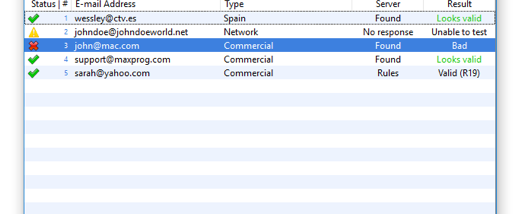
#Email verifier professional how to
īest Email Verification Services of 2023: Prices And Featuresġ March 2023 How to check if email is valid Don’t know how to check your sender reputation? Find out here. Consistently using email verification services in your marketing will help you maintain a high sender reputation and avoid blacklists. We’ve already mentioned bounce rate and deliverability, but there’s also spam report rate and your sender habits (never forget to warm up new email accounts !). Your sender reputation depends on a number of things. Speaking of… Reason 4: It maintains high sender reputation This helps save on email sending and, once again, preserves your email sender reputation. Subsequently, your email deliverability stays high. When you use an email verifier to filter out invalid email addresses, you can be sure that those that remain are capable of receiving emails, meaning your messages reach the inbox. Reason 3 : It improves email deliverability

Once it crosses a critical threshold, your account gets blacklisted. When your bounce rate grows, your sender reputation falls. High bounce rates are usually indicative of spammers, which is why ESPs don’t treat users with high bounce rates kindly. Reason 2 : It reduces hard bouncesĪ hard bounce is an email that returns to the sender because the recipient doesn’t exist, i.e., the email address is invalid.
#Email verifier professional pro
Pro tip: verify your email list once every two months. If you don’t verify email lists regularly, in a year, the 22.5% bounce rate will exceed the acceptable bounce rate tenfold, and your sender reputation will take a real hit. Most often, it’s because people change companies, and their corporate email addresses you have on your list get deactivated. That’s not your fault this happens naturally due to various external reasons. Yearly, 22.5% of email addresses become invalid. Reason 1 : It helps keep your email lists fresh If you doubt why you need to check email validity, let me show you why email verification matters and why ignoring it when doing email marketing can lead to catastrophic campaign issues that will take weeks to resolve. Why you shouldn’t skip email verification Depending on the result, an email gets one of the email verification statuses, usually “valid,” “invalid,” and “unverifiable” (often marked by green, yellow, and red colors) Sometimes, validation also implies checking any additional information that comes with the lead’s email or checking the source of that lead. The most common are the syntax, domain, catch-all, and MX record checks, as well as email address ping (you will read about them in detail further on in the article).Įmail validation is the final result of the email verification process that’s provided to the user. Every email verifier, either bulk or single, performs (or is at least supposed to) multiple steps of the verification process. A valid email is the one that can receive messages from other senders.

Online, in every blog and on every website, people use verification and validation interchangeably however, the correct definition is slightly more precise.Įmail verification is the process of checking an email address for being existent and active, aka valid.

If only you knew how much time and effort it took me to find out the exact difference between these two. What is email verification (and how is it different from email validation) Why you shouldn’t skip email verification.


 0 kommentar(er)
0 kommentar(er)
